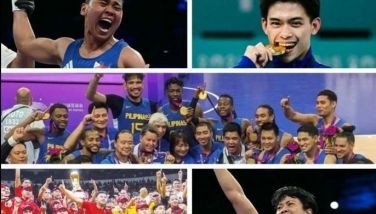Finally, Asian imports
The Philippine Basketball Association is making some radical innovations in its 40th season. With its landmark birthday celebration beginning with the Chairman’s Ball at Resorts World on Oct. 14, the league will be premiering “PBA: A Nation’s Passion”. It will be the first-ever full-lengths feature documentary to be shown in Philippine cinemas. This is another pioneering project which has never been done in the league’s history. The film traces the events that led to the formation of the PBA, its struggles through Martial Law, the most impactful events revolving around its first 40 years, and celebrates the colorful personalities who have left indelible memories on Filipino basketball fans’ consciousness.
Almost all of the pillars of the league from its inception are included in the film, 55 main interviewees in all, including past and present team owners, league legends, champion coaches, current superstars, and other recognizable persons who have helped shape the image of the PBA. The production team covered such as areas as San Francisco, Sacramento, Irvine and Los Angeles in California, and several locations within Metro Manila, and even Cebu. All the interviewees, including players for our top wheelchair basketball teams and former women’s national team players, were all absolutely selfless on their sharing. It will give the film a rich texture and depth of insight and emotion. The creative team is virtually the same group behind the ground-breaking miniseries “Pinoy Hoops”, which racked up 12.8 million hits online in only its first run on the National Geographic Channel last year.
From where it has come from, where will the PBA be heading in Year 40?
One of the main thrusts of new PBA board chairman Patrick Gregorio is “Asian integration”. The PBA is acknowledged as one of the most successful, pioneering professional leagues in the world, just as Filipinos have been known globally as the most passionate fans of the sport, well before the accolade given at the FIBA World Cup. With that respect also comes the motivation to test itself against the best players of the Asian region. One of the first steps taken by the PBA’s leadership was a visit to the Korean Basketball League’s 10-story office building in Seoul to discuss possible partnerships. Gregorio, league commissioner Chito Salud, special assistant Willie Marcial and operations chief Rickie Santos met with their counterparts with the KBL. KBL commissioner Kim Young Ki and secretary-general Jae Min Lee welcomed the idea of possible partnerships, and also expressed a desire to have PBA stars to play in their league.
This symbiosis only makes good business sense. First of all there are reportedly over a million Korean nationals in the Philippines, many of whom are studying business or English in colleges and universities from Metro Manila to Baguio, Cavite to Cebu, Davao to Zamboanga. Korean churches, Korean-language newspapers and restaurants have sprouted to cater to this growing market. Korean entertainment, from their television dramas and music, have permeated the airwaves in the country. It only makes sense to likewise tap this large sector of the youth market as a new audience for the country’s favorite sport. Koreans, like Filipinos, are very passionate when they support anything they truly like, a few years ago, even small schools were manifesting this growing interest. Almost a decade ago, tiny Benedictine International School in Quezon City even had an all-Korean basketball team outside of its varsity squad. The players were students who were not that talented, but just wanted to both play the game and represent their school in something.
This is only the tip of the iceberg. For the season-ending Governors Cup, the PBA will not only handicap the imports, they will also allow the teams the option to field a second, Asian import with a height limit of 6’4”. This is another brilliant step in expanding the league’s reach outside of its shores.
Why is this move being made on solid ground? Filipinos have been playing overseas as imports for decades. The ASEAN Basketball League features three Filipinos on every other team except those based in the Philippines, this is an acknowledgment of the skill of Filipino player in Southeast Asia, as it is in other sports like rugby, soccer and billiards. Filipino schools like Ateneo de Davao field basketball teams to competitions like the Arafura Games in Australia. Current and past PBA players have played in large Overseas Filipino Worker (OFW) communities not just in Asia, but everywhere in the world. Markets like mainland China and Taiwan have become great new markets for basketball in general. The NBA played its first NBA China Games in Shanghai and Beijing in 2004.
How will this help Filipino basketball in general? First of all, the differences in influence have brought about different ways of teaching, learning and playing the game, in ASEAN, the Philippines is the only country directly influenced by the US. Most other countries have European influence. It has only been in recent years that international leagues like the NBA have made inroads into these countries. Also, many Asian countries have been under European coaches, lending a different style and flavor to their game. The fundamentals are similar but not the same. Conceptually, outside shooting is better in Korea, for example.
If Asian imports were to play in the PBA, the transfer of technology would also help us learn new things about our Asian opponents, entire teams will be able to study their Asian teammate, while only one of these foreign visitors will be able to report back what they’ve learned. For example, what makes the Koreans such consistent shooters? But hamstrung with the language barrier, their learning about Philippine basketball may not be as deep as one would think. Meanwhile, they will be likely to share what they’ve learned in their countries with their coaches and teammates. The reciprocal relationship will work to the PBA’s advantage.
The idea of having Asian imports has been discussed over the last fifteen years, but perhaps it is time to try this new approach to the game. After all, since the Americans first brought the game to the Philippines in the late 1980’s, it has gone through so much evolution. Today, the PBA is taking the next step to further evolve the game of basketball, making it even richer for future generations to experience and enjoy.
- Latest
- Trending
























